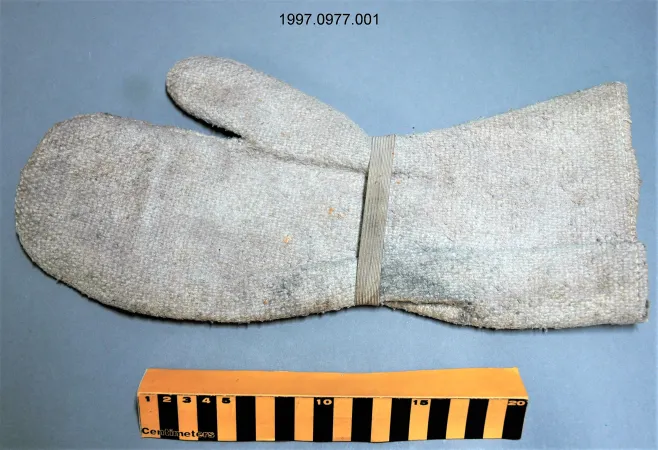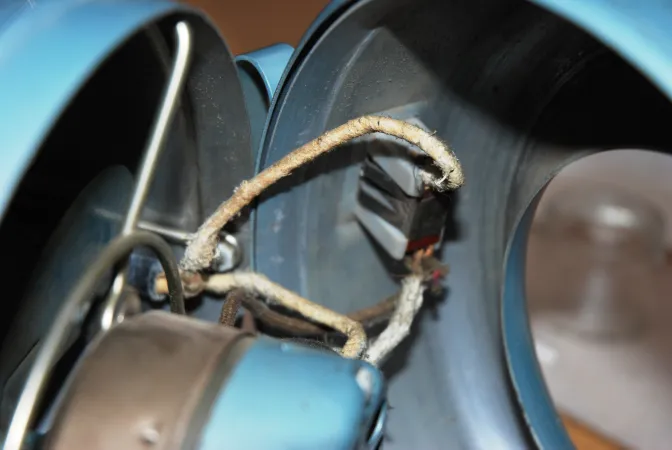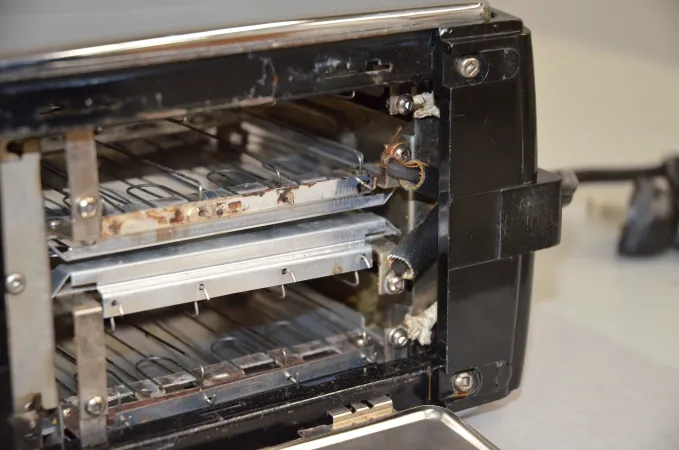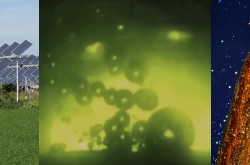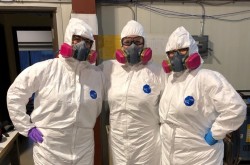Artifacts and asbestos: Managing hazards at Ingenium
Once known as a wonder material for industrial and commercial manufacturing, asbestos now raises alarm bells as a cancer-causing agent. With this infamous reputation, asbestos is typically avoided — but sometimes it comes with the job. For the Conservation team at Ingenium – Canada’s Museums of Science and Innovation in Ottawa, managing asbestos in artifacts requires special training and attention to detail. Let’s take a closer look at the history of asbestos and how it’s managed in the museum setting.

During the move, items such as this panel were discovered in a drawer full of other asbestos-containing materials manufactured in Canada. They were retained as product samples for testing by the Dept. of Mines Geological Survey of Canada.
Asbestos mining in Canada
In its raw form, asbestos is a family of fibrous silicate minerals that can be mined from the earth. The microscopic, stringy fibers are what make it strong — and also problematic. The fibrous quality allows asbestos to be turned into threads and woven into different types of fabric. The natural structure of asbestos can withstand high temperatures and temperature fluctuations, while maintaining its physical and chemical properties. All of these factors make asbestos an ideal insulator.
Worldwide, the commercial mining of asbestos ramped up in the early 1800s, when hand tools were used to separate asbestos from surrounding materials. There are six types of asbestiform minerals; the most common is called chrysotile. Chrysotile asbestos accounted for approximately 95 per cent of asbestos manufacturing from the 1850s until the 1980s, though the onset of World War II resulted in declining production in most regions of the globe except Canada, South Africa, and the United States.
By 1878, the town of Val-des-Sources (formerly known as the town of Asbestos) in Quebec had started mining asbestos in large quantities for commercial use. The mined asbestos was processed into boards or fabrics, and used to make objects such as gaskets, electrical wiring insulation, building materials, and insulation for kitchen appliances.
Historic firefighting suits were made out of asbestos material as well. Asbestos can also be combined with other materials to help enhance their own properties – these are called Asbestos Containing Materials (ACMs).
The demand for asbestos peaked around 1977, when about 25 countries were producing almost 4.8 Mega tonnes of asbestos per year, and about 85 countries were manufacturing asbestos products. Asbestos was heavily used in Canada until 1981, when the Government of Canada began implementing regulations on its use in commercial goods. During this time, the use of asbestos in new materials drastically decreased. In 2018, the Government of Canada passed legislation making it illegal to import, manufacture, sell, trade or use products made with asbestos, though its usage is still legal in a few highly regulated cases.
Why is asbestos hazardous?
The hazardous aspect of asbestos relates back to its stringy fibers. When compacted lengthwise, asbestos fibers can be very strong and stable. However, when these fibers get too agitated, they can break off into dust-like particles — much like microscopic needle shards. When asbestos particles are inhaled by a person, the shards can pierce and damage respiratory organs. Repeated exposure can result in a lung disease such as asbestosis, or cancer (such as mesothelioma). The damage is dependent on exposure levels and is typically worse for those exposed to asbestos in the workplace. Solid, or non-friable asbestos, does not pose the same risk.

Assistant Conservation Technician Skye Marshall consolidates asbestos on a water pipe insulation jacket, using a canvas patch dipped into Childer’s lock CP-240, then applying an encapsulant called CP-211 with a brush.
Asbestos safety at Ingenium
The Ingenium museums care for the national science and technology collection, which represents Canada’s history. A large percentage of artifacts in the collection were crafted with materials that are now banned from production — including asbestos. As a result, our collections and conservation team are highly trained in hazard identification and safe work practices for artifact hazard management.
As asbestos is typically found in artifacts that were used in high heat environments, the Ingenium conservation and collections staff can often identify asbestos-containing artifacts very quickly by assessing an object’s context and use.
To prepare to look at a possible asbestos-containing object, our conservators protect themselves with ventilation and Personal Protective Equipment (PPE). A respirator with a P100 filter, 6 mm nitrile gloves, and a lab coat are common accessories for our conservators. These prevent the inhalation of asbestos particles or the contamination of clothing. In more extreme cases, Tyvek suits and goggles are used.

Assistant conservation technician Briana Ippolito is dressed in a lab coat, respirator, and nitrile gloves. She is conducting an asbestos encapsulation treatment on a motor using an encapsulant called CP-211. She is holding a brush and a vacuum, and a small light is illuminating the working area.
Ingenium has asbestos preparedness kits and safe practice flow charts to aid in the containment of asbestos. When an artifact has asbestos that was not previously identified, the object is HEPA vacuumed before being safely contained. Next, a hazard label is added to the object — and to our digital files — to make it easily identifiable in the future.
Asbestos identification in artifacts
Asbestos is a very versatile mineral which can take many forms. It can be woven into fabric, braided into rope, pressed into paper, stuffed into insulation, and more. That being said, the strength and longevity of asbestos means it can also be found hiding in plain sight. For this reason, the conservation team must be able to identify asbestos in all of its forms.
The list of all materials containing asbestos is too long to include. However, here are some examples of asbestos-containing artifacts that we often come across in the collection:
• Gas range stoves
• Heaters
• Motors
• Toasters
• Electrical cords
• Protective clothing and equipment
• Brake pads
The conservation team looks for common asbestos characteristics, paying particular attention to “friable” versus “non-friable” asbestos. Friable asbestos refers to asbestos that is loose and fluffy or can be crushed in your hand, whereas non-friable asbestos is typically pressed or coated to keep the fibres together. Non-friable is safer to handle and often requires no further treatment as there is little risk in handling it. The following photo gallery shows different forms of asbestos found in our artifacts.
Image gallery

The interior of a power switch from the Ontario Hydro collection; notice the rows of coils interleafed with sheets of friable asbestos.
How much asbestos is too much?
All objects in the Ingenium collection hold significance, in terms of the development and application of science and technology in Canada and around the world. However, the safety of our staff and the public is central to how Ingenium manages its collection. When an object is considered too hazardous to safely manage, it can be considered for deaccession. Deaccessioning is the process where an artifact officially leaves a museum collection, be it for safety reasons or otherwise. In this case, if an object has a large amount of friable asbestos and cannot be safely handled by our staff or put on display, we might consider it for deaccession.
This process can be challenging because we have to weigh the importance of the object — its research value and provenance — with how hazardous it is. Some objects can be encapsulated or treated so the asbestos is contained, making the object safe to handle. If the asbestos cannot be contained and the artifact is deaccessioned, we ensure that we have as much information about the object as possible, so a story can be told and the information can be recorded and maintained. Any work we do will alter the object, changing it from its original, intended state; this must be thoroughly documented and accounted for, as it will impact the way future generations see and interact with our collections. This is an important part of conservation practice.
The image of a power switch to the right is an example of an artifact that was deemed too hazardous to keep in the collection and was sent for hazardous waste disposal.
The #IngeniumBigMove
In 2017, Ingenium staff began planning and moving artifacts from the old storage warehouses to the new Ingenium Centre, a state-of-the-art collection storage facility located beside the Canada Science and Technology Museum. This move has allowed us to put a set of eyes on every single artifact. With our highly skilled and trained team, we have been able to identify, manage, and remediate more hazards than ever before.
Since the National Museum of Science and Technology opened back in 1967 (the predecessor to the Canada Science and Technology Museum), hazard standards and procedures have evolved. Some items in the collection precede current policies, so the move provides the perfect opportunity to examine all of our objects and update our safe work practices accordingly. During this evaluation process, asbestos has become one of the most common hazards our team identifies and manages. In most cases, asbestos is identified, contained, and tagged for easy future identification. Moving artifacts into their new forever home in the Ingenium Centre is allowing us to make our collection safer than ever before.
Enjoying the Ingenium Channel? Help us improve your experience with a short survey!




